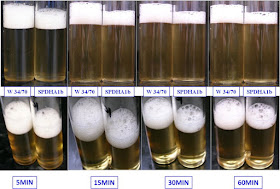 |
| Fear the frankenyeast! |
So what was really discovered? What does it do? What does it mean? All is explained, below the fold.
Before describing exactly what was found, we need to quickly mention how a yeast cell is built. Like all living things - from the most primitive of bacteria to you and I - the inside of yeast cells are separated from the outside world by a membrane comprised of a lipid bilayer. Believe it or not, these barriers between cells insides and the outside world has the consistency of room-temperature margarine! Not exactly a brick wall. We humans protect our cells by having things like skin, bone and connective tissue to give support to these rather mushy membranes. Being unicellular organisms, yeast don't have this option.
Instead, yeast have a "wall" surrounding this membrane. This wall - composed mostly of a starch-like molecule called beta-glucan - provides structural strength. But beta-glucan isn't enough; you need anchors to bind the wall to the cell, ways to move nutrients and waste efficiently through the wall, machinery to repair the wall, and so forth. These additional capacities are provided by proteins embedded in the wall. And proteins, as yo hopefully know, is what is encoded in our (and yeast's) DNA.
 The foam-creating protein is one of these cell wall proteins - named CFG1 (short for Carlsbergensis foaming gene 1), and was identified in the lager yeast Saccharomyces pastorianus. For any geneticists/biologists that happen by, here is the full genebank record for CFG1. This gene is very similar to other genes identified in ale yeasts, and therefore likely represents a universal mechanisms used by yeast to improve head retention...
The foam-creating protein is one of these cell wall proteins - named CFG1 (short for Carlsbergensis foaming gene 1), and was identified in the lager yeast Saccharomyces pastorianus. For any geneticists/biologists that happen by, here is the full genebank record for CFG1. This gene is very similar to other genes identified in ale yeasts, and therefore likely represents a universal mechanisms used by yeast to improve head retention......OK, that was an evolution joke - yeast don't give a damn about head retention, but the side-effect of this genes real purpose is one we like; foamy, delicious beer.
The protein itself is a cell wall protein anchored to the underlying membrane by a GPI anchor; basically, a lipid "anchor" linking the yeast membrane to the protein. The protein itself is heavily glycosylated - meaning a lot of sugars (mostly mannose) are attached to it. These sugars make the protein electrically charged & hydrophillic - AKA water loving. But oddly, this protein also has large portions of uncharged, hydrophobic (water-hating) regions. So its kindof a schizophrenic protein - part of it is covered in water-loving charged sugars, other parts of it are water-hating hydrophobic regions.
All of that is interesting - if you're a biochemist - but what does it mean in the real world? Turns out that CFG1's purpose is to stabilize the yeast cell wall; deleting the gene doesn't effect yeast growth or change characteristics like a beer's pH or attenuation. But removing the gene does make the yeast more susceptible to things that damage their cell walls such as detergents. Yeast lacking it also grow slightly slower at cooler temperatures - an issue for lager brewers, should one try to brew a beer using a yeast missing this gene. Not that you would want to use this strain - as you can see in the figure below, knocking out CFG1 (beers labelled SPDHA1b) leads to less head formation and poorer head retention, compared to the parental (non-altered) strain (W 34/70).
 |
| Adapted from Figure 6, Blasco L et al. (2012) J. Agric. Food Chem., 60 (43), pp 10796–10807. |
One day perhaps, a yeast strain genetically engineered or bred to over-produce this protein could be used to provide superior head retention, especially in low-malt or high-alcohol beers which traditionally have head-retention issues. But, contrary to all the cries of 'frankenyeast' by various foodie and brewer bloggers/news wires out there, no such yeast were made by these researchers. They removed the gene; they did not create a strain which over-produces this protein, and no brewer is going to want the non-head producing 'frankenyeast' made in this study.
No comments:
Post a Comment
Note: only a member of this blog may post a comment.